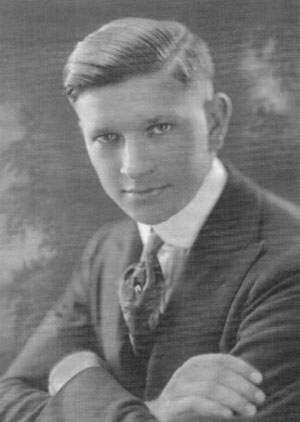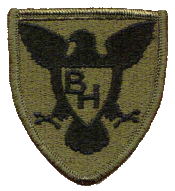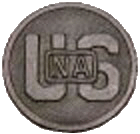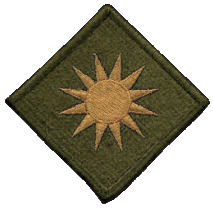Raymond Before The War
Raymond W. Baer,
son of Catherine (Loehrer) and Charles E. H.
Baer, was born in Madison, Wisconsin in
September 1895. The family lived in
downtown Madison on an isthmus just two blocks
west of the Wisconsin State Capitol building.
Ray had one younger sister Lillian G. (King) and
an older brother Joseph J. Baer. Their Victorian
era home was on the back side of a block along
State Street at 115 West Johnson Street, living
just two doors down from the Orpheum Theater's
stage door. The old home with fine interior
hardwood was torn down in the 1970s along with
several others, a parking ramp now bordering W.
Johnson, N. Carroll, and W. Dayton Streets was
built.
His father
"Charley" was a successful traveling salesman
for the Gould, Wells & Blackburn Co., wholesale
grocers at
634 West Main Street, from 1898 to around
1915. The business became Universal
Grocery Co. then later Kroger Grocery and Baking
Co. around 1930. The extant four-story
building is located 3 blocks over and 6 blocks
down from the old Baer house. Life for the
Baer’s must have been convenient, living and
working in such close proximity, in the heart of
downtown. Within a few years Charles was
named Secretary of the
Globe Baking Company corporation. A
slightly smaller operation, it was located at
219-23 East Main Street on the east side of the
Capitol Square, a little closer to home.
Two Madison city directories list Charles as
employed by both companies around 1917.
The old Globe building sat on the southwest
corner of E. Main and S. Butler Streets and was
torn down around 1971-72 for the current
multi-story G.E.F. II state office building.
The First World War,
1914-1918
When a Serbian
nationalist assassinated Archduke Franz
Ferdinand (heir apparent to the Austro-Hungarian
throne) in Sarajevo on June 28, 1914, it set off
a gigantic explosion we now know as World War I.
There were many other volatile elements combined
which lay blame to the cause of the Great War.
Scholars say it was a desire for greater empire,
wealth and territory. A massive arms race. The
series of treaties which ensured that once one
power went to war, all of Europe would quickly
follow. Social turmoil and changing artistic
sensibilities brought about by the Industrial
Revolution is another debated cause. It was also
considered a miscalculation by rulers and
generals in power.
True to the
military alliances, Europe's powers quickly drew
up sides after the assassination. The allies --
chiefly Russia, France and Britain -- were
pitted against the Central Powers -- primarily
Germany, Austria-Hungary and Turkey. Eventually,
the War spread beyond Europe as the warring
continent turned to its colonies and friends for
help. This included the United States, which
joined the War in 1917 when President Woodrow
Wilson called on Americans to "make the world
safe for democracy."
Most of the
leaders in 1914 had no real idea of the war
machine they were putting into motion. Many
believed the War would be over by Christmas
1914. But by the end of the first year, a new
kind of war emerged on the battlefield that had
never been seen before -- or repeated since:
total war-producing stalemate, the result of a
war that went on for 1,500 days. Before the
official Armistice was declared on November 11,
1918, nine million people had died on the
battlefield and the world was forever changed.
The Great War
Prologue by PBS
The Draft
Congress passed the
Selective Service Act in May 1917, requiring all
men of draft age to register. The first
names were drawn on July 20, 1917. Shortly
after, notices to appear for draft board
examinations were sent out. Inductees
would not have to report to their particular
camps until September 5, 1917.
On September 18,
1917, Raymond was inducted at Madison,
Wisconsin just four days before his 22nd
birthday. His service and bonus card
indicate brown hair, fair complexion, 5’-10” of
height, and his occupation as “laborer”.
In the Madison City Directory for 1917 Raymond's
occupation is listed as a "foreman" for the
'Wisconsin Telephone Company' and was living at
home with his parents on 115 West Johnson
Street.
The time before his departure must have been
surreal as he said goodbye to family and
friends. He was embarking on a journey to
new places and experiences. Leaving
Madison with no more than one suitcase, Raymond
was off to the new National Army (cantonment
still under construction) outside of Rockford,
Illinois - Camp Grant. During the dawn of
the automobile era there were few paved highways
connecting cities and reliable cars - Ray
probably traveled the 75 miles to Rockford by
railroad.
Ray's brother
Joseph "Cody" Baer entered the infantry
7 months later on April 26, 1918 and also
trained at Camp Grant. Cody, 24 years
old, trained and was with Company 5 of the
161st Depot Brigade to May 31, 1918, then
went onto the “School for Bakers and Cooks
”.
See his service cards. He
was promoted to Sergeant First Class on
September 17, 1918 and remained at Camp
Grant, Illinois through the war's end and up
to his discharge on February 9, 1919.
Stationed at
Camp Grant at the same time for 5 months,
both brothers may have seen each other, in a
chow line or off duty. The phrase
“Doughboy” must have had some personal
meaning, considering the family was in the
baking business.
After the war their
father Charles, as president of the Globe Baking
Company, brought his two sons on board as
officers of the corporation. Raymond
became "secretary-manager" and his brother Joe
was "vice-president". The Globe Baking
Company became defunct corporation around 1928
for unknown reasons. Charley was 64 years
old and may have sold the business to retire.
Raymond is
mentioned in the March 1929, Wisconsin Alumni
Magazine as a U.W. graduate in 1918. The
paragraph cites, " Ray Baer is part owner of The
Southern Wisconsin Insurance Agency, Madison."
The agency started in 1928 and evolved into Ray
W. Baer and Sons Insurance. No longer a
family owned business it is called Baer
Insurance Services.
Training
Trainloads of
inductees from all over Illinois, Wisconsin, and
Minnesota were mobilized pouring into Camp
Grant, which was a wheat field only a few months
previously. They arrived at a new
railroad
depot
station inside the camp. Some of the
inductees arrived in the city of Rockford and
were transported on buses and trucks in through
the camp's
main gate.
Camp Grant was the largest training facility
in the Midwest and named after Ulysses S. Grant
18th president of the United States.
Construction of the National Army cantonment
started in June 1917. The 86th Infantry Division
was activated there on August 3, 1917 under the
command of Major General Thomas H. Barry. The
first draftees arrived just a few months later
in September the same year. Their primary focus
was on infantry-related field skills and would
train over 56,000 troops during WWI, with an
estimated one million people passing through in
some capacity.
Today the property
currently occupied by the Rockford airport and
the Rockford Park District's
Atwood Park, was once a bustling and active
5,460-acre site. In fact, the camp's original
stone pillered entrance remains visible today at
the intersection of Kishwaukee Street and
Airport Drive.
Ray was first assigned to Company A, of the
331st Machine Gun Battalion as "Divisional"
Troops for the 86th “Black Hawk” Infantry
Division. One month after induction at Camp
Grant, he was given the rank (or grade) of
sergeant on October 20, 1917.
In one of Camp
Grant's first waves of troops to ship out,
Raymond left Illinois heading east and arrived
at Camp Mills, NY a troop staging cantonment on
Long Island. Officially, he departed the U.S. on
September 9, 1918 from the Port of Embarkation
at Hoboken, NJ aboard the troop ship
"Empress of Asia".
The Eighty-Sixth
Infantry Division Of The National Army
On September 8, 1918, the division, under the
command of Major General Charles H. Martin, left
for Liverpool, England. After a brief stop in
England, the Blackhawks sailed to the French
ports of LeHavre and Cherbourg.
Shortly after arriving in France, the 86th
was once again given the mission of providing
replacements for the divisions which were
already on line. By the middle of October it had
become completely skeletonized. Although plans
were made to bring the 86th up to
strength for later use, the Germans surrendered
on November 11, 1918. The division was
then reduced to a cadre. General Martin was sent
to take command of the 92nd
Infantry Division.
The 86th Infantry Division cadre,
composed of only 17 Officers and 124 enlisted
men, arrived back in the United States in
January, 1919. The division was deactivated soon
thereafter, at the place of activation - Camp
Grant, Illinois.
(History of the 86th Infantry Division:
www.86blackhawkdiv.org)
Raymond In Europe
In France, Raymond's unit the 86th "Black Hawk"
Division did not see combat during the war.
Like so many other divisions the 86th was "skeletonized"
upon arrival. Consequently, his comrades
were immediately split up and used as
replacements to fill the dwindling ranks in
other combat units on Germany's western front.
He remained with the 86th Infantry Division,
which became a small cadre of officers and
enlisted men who were assigned to train and
process soldiers.
The following Stars and Stripes article
"THE
DEPOTS" describes, with some frustration,
how these men trained as combat units then
suddenly denied there chance to fight,
reorganized and used instead to train more raw
recruits for the front. Receiving raw
replacement troops from the U.S. and allied
forces they had to billet, feed, instruct,
discipline, and father them all within 10-14
days before sending them to other units in the
trenches on the front line.
Exactly what tasks
Ray Baer performed is unknown. He probably
worked many long hours day and night for several
months as a machine gun intructor and helped
process troops back and forth to the front.
Bill Morrissey, his sister in-law's son recalls,
"He was gassed.", during the war. A nearby
gas attack may have been very likely, since
training cadres were often located near the
front. But officially, he never saw combat
while in France; the war came to a close 63 days
after his arrival.
On January 4, 1919,
he was transfered to an entirely different unit,
the 40th Infantry "Sunshine" Division from
California's National Guard. Once again he
was separated, permanently, from the Illinois
cadre his pals of the 86th Infantry Division.
The majority of the division was sent home in
January and demobilized at Camp Grant, IL while
he remained in France.
Ray Baer was
assigned to Company A, 144th Machine Gun
Battalion, 79th Infantry Brigade of the 40th
Infantry "Sunshine" Division at Castres (Grionde)
France. The 40th Division was also
skeletonized when it arrived in France and fell
under the control of the 6th Depot Division.
Members of the unit were sent as indiviudals to
other units. Those units who remained with
the 40th Division (and it seems like this would
include Ray Baer) set up camps to process
soldiers. The 144th MG Bn was in charge of a
classification camp at Revingy.
On February 9, 1919
he was transferred again to another company
within the same unit, Company D, 144th M.G. Bn.,
79th Inf. Brig., 40th Inf. Div. where he served
until his discharge.
He departed from France and arrived in the U.S.
on April 17, 1919. While his military
service ended with the men of California's 40th
Infantry Division, his point of was discharge
was at Camp Grant, Illinois on April 29, 1919.
Attitudes were
different in the early 1900s. In 1918, it
is hard to imagine how much these "doughboys"
wanted the opportunity to prove themselves in a
war. According to accounts, 'They went
willingly to the front in truckloads proudly
singing loud enough for the enemy to hear their
songs of victory.' During the Battle of
the Marne, over one-million died in less than a
week. When the U.S. finally arrived in
Europe, it was the overwhelming numbers of
allies that brought the war to a close.
The armistice was
signed at 5 a.m. on the morning of 11 November
1918, and came into effect six hours later at 11
a.m. (hence the oft-quoted 'eleventh hour of the
eleventh day of the eleventh month').
|



%20copy.gif)

%20copy.gif)